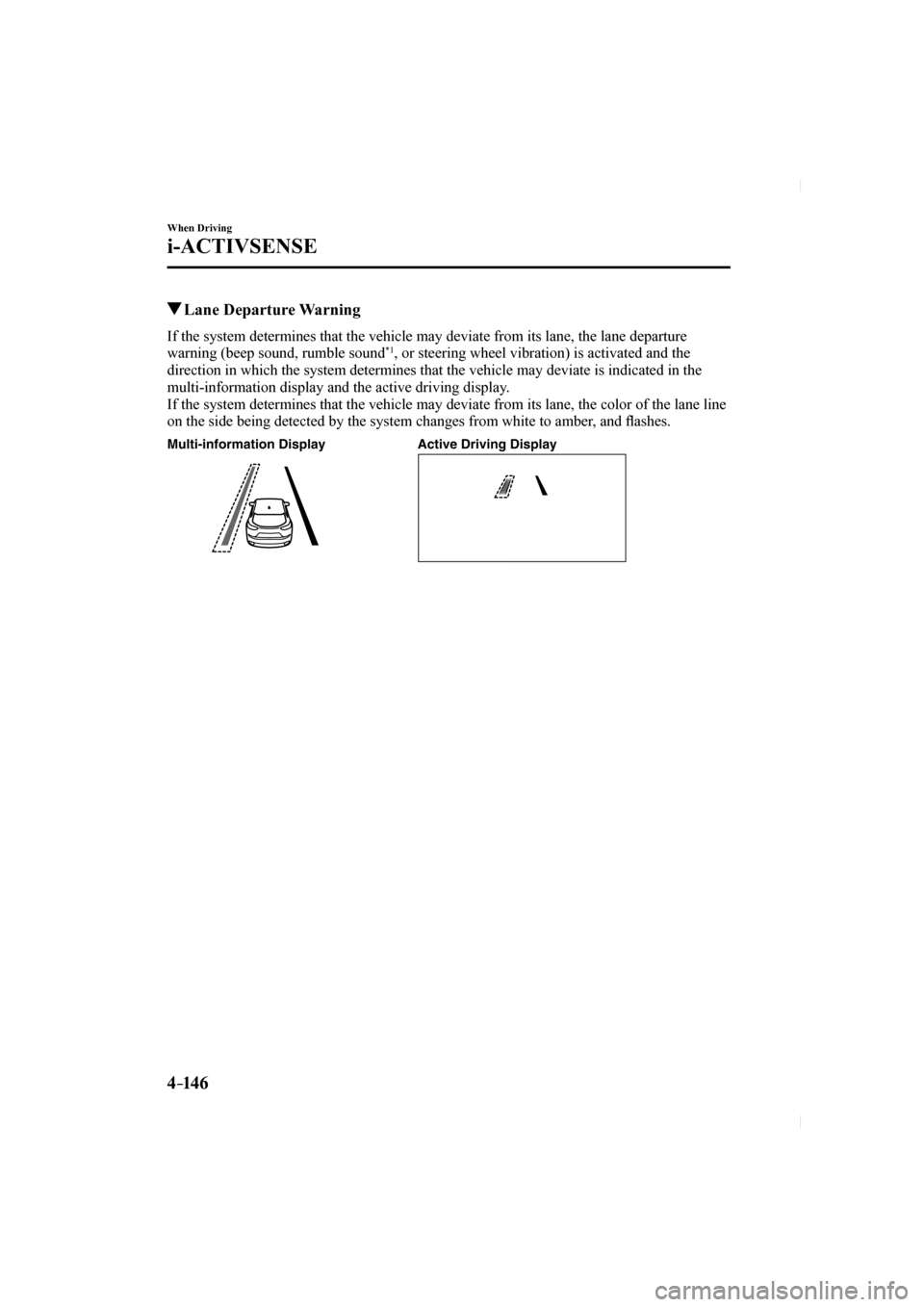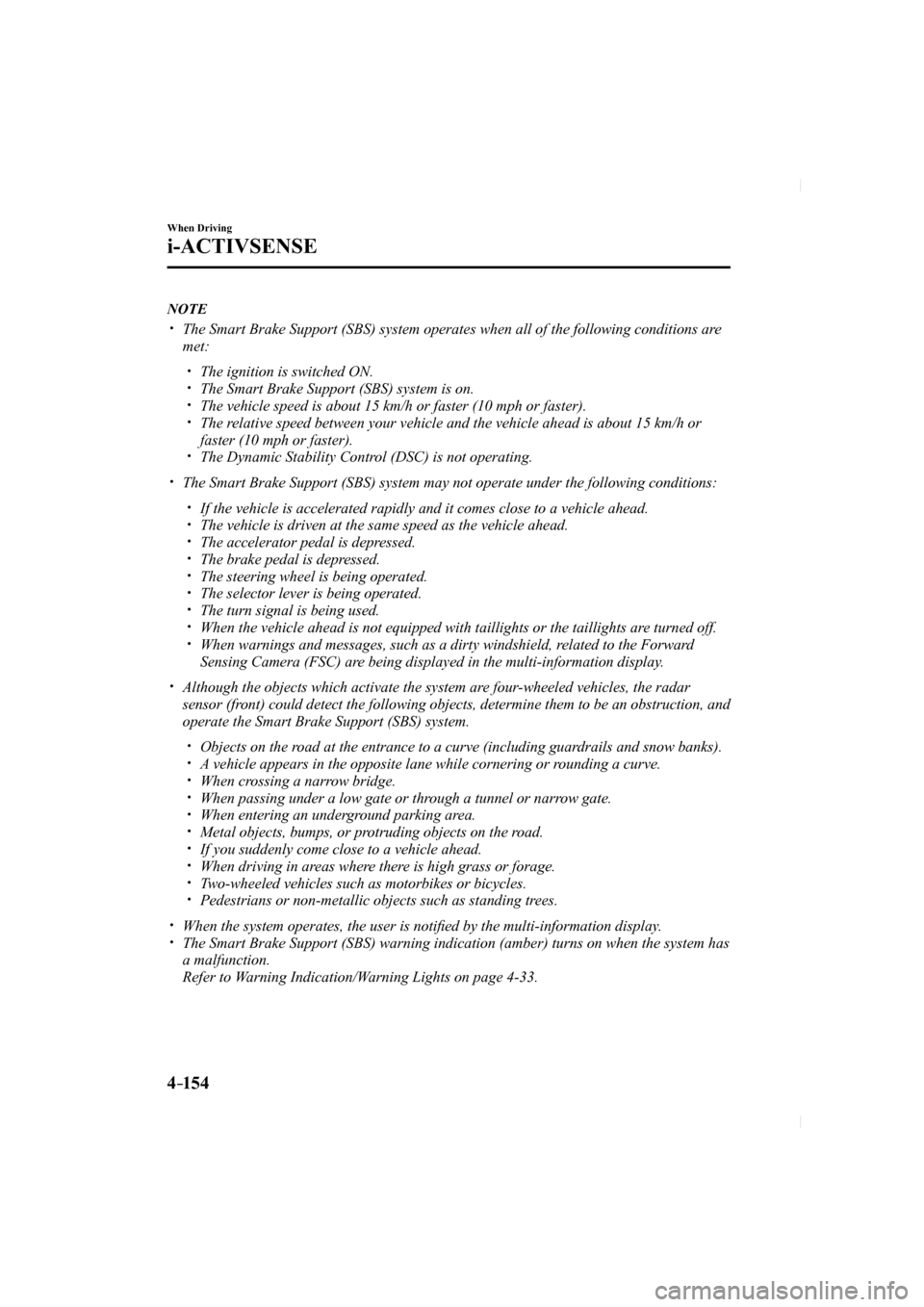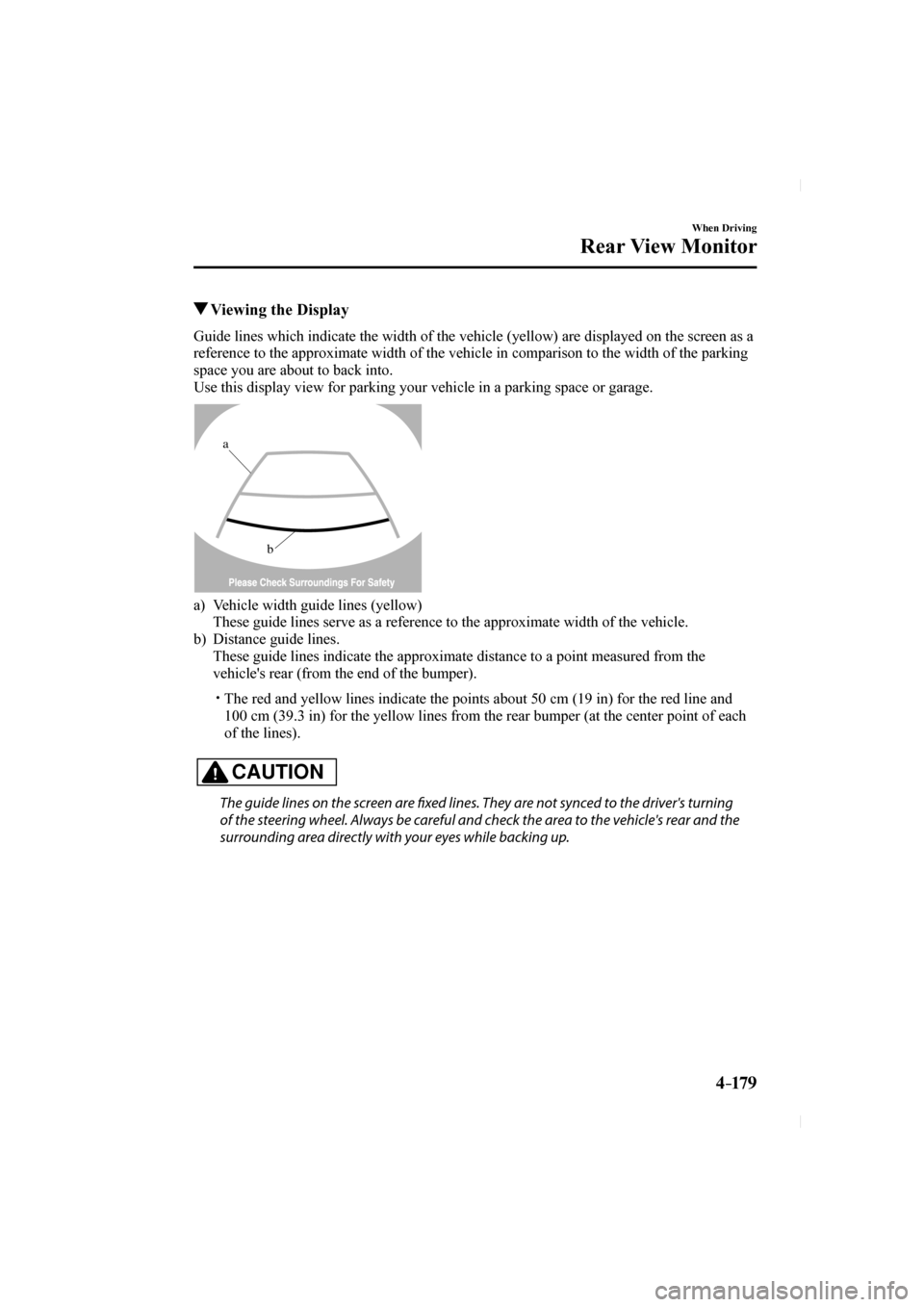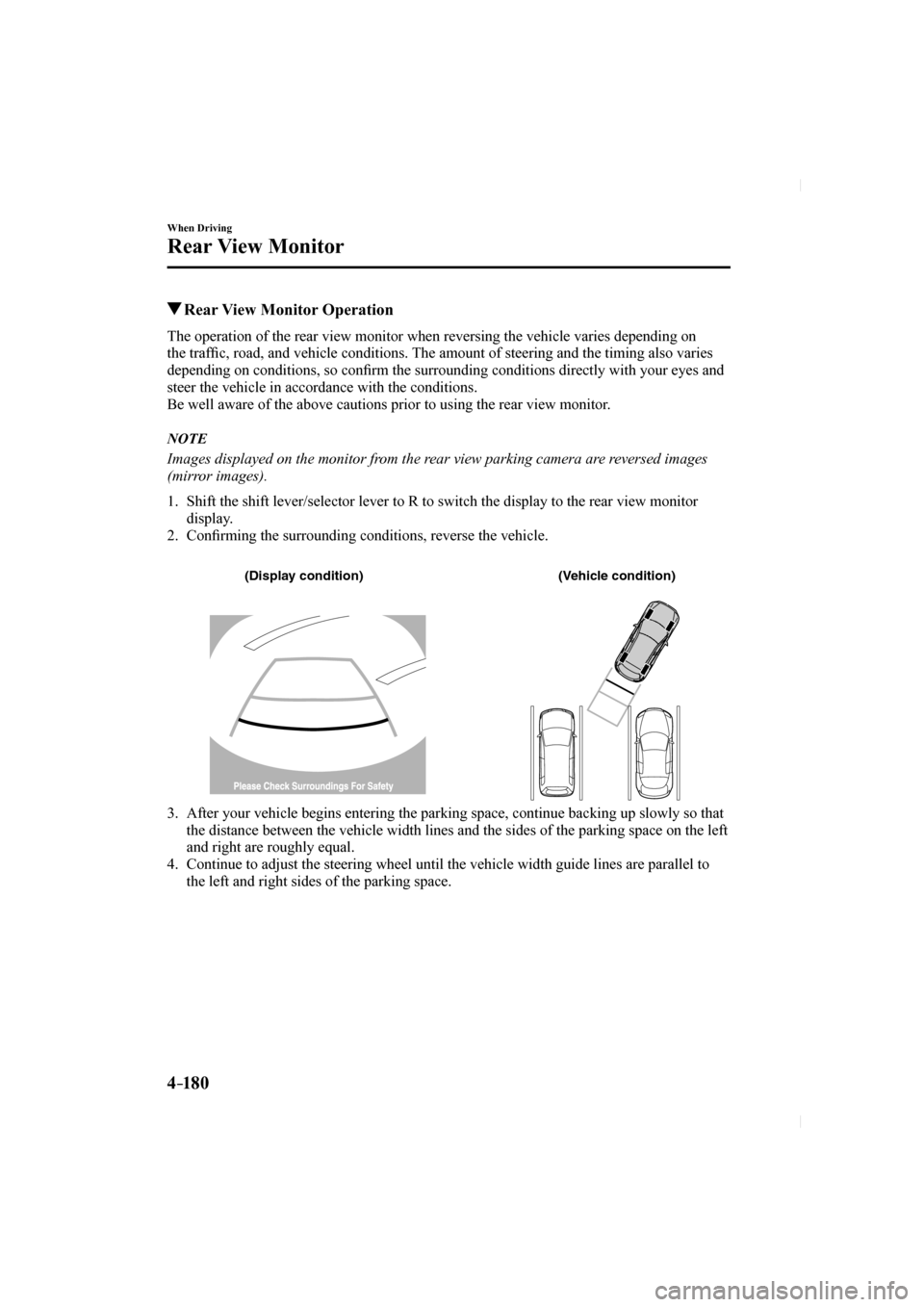2017 MAZDA MODEL CX-5 steering wheel
[x] Cancel search: steering wheelPage 290 of 664

4–14 6
When Driving
i-ACTIVSENSE
Lane Departure Warning
If the system determines that the vehicle may deviate from its lane, the\
lane departure
warning (beep sound, rumble sound *1 , or steering wheel vibration) is activated and the
direction in which the system determines that the vehicle may deviate is\
indicated in the
multi-information display and the active driving display.
If the system determines that the vehicle may deviate from its lane, the\
color of the lane line
on the side being detected by the system changes from white to amber, and fl ashes.
Multi-information Display Active Driving Display
CX-5_8FN1-EA-16L_Edition1.indb 1462016/12/12 10:06:15
Page 291 of 664

4–147
When Driving
i-ACTIVSENSE
NOTE
If you have set the lane departure warning sound to the beep sound/rumble sound *1
setting, the warning sound may not be heard depending on the surrounding noise
conditions.
If you have set the lane departure warning system to the steering wheel vibrations setting,
the vibration may not be felt depending on the road surface conditions.
When the setting for the steering operation assist is changed to operati\
onal, the warnings
can be set to activate/not activate. (When the setting for the steering\
operation assist is
changed to non-operational, the warnings cannot be set to not activate.)\
Refer to Setting Change (Personalization Features) on page 9-11 . The Lane-keep Assist System (LAS) & Lane Departure Warning System (LDWS) can be
changed to the following settings regardless of whether the steering operation assist has
been set to operational/non-operational. Always check the setting status when driving the
vehicle and make setting changes if necessary.
Refer to Setting Change (Personalization Features) on page 9-11 . Steering wheel vibration: Strong/weak Warning sound volume Types of warnings (steering wheel vibration/beep sound/rumble sound *1 )
*1 A rumble strip is a series of grooves in the road pavement surface positioned at speci fi c
intervals, and when the vehicle passes over it a vibration and rumble so\
und is produced
which alerts the driver that the vehicle is departing from the lane.
The rumble sound is a reproduction of the sound which occurs when a vehicle passes over a rumble strip.
Rumble
Groove
CX-5_8FN1-EA-16L_Edition1.indb 1472016/12/12 10:06:15
Page 294 of 664

4–150
When Driving
i-ACTIVSENSE
NOTE
The Smart City Brake Support (SCBS) system will operate under the foll\
owing conditions. The engine is running. The Smart Brake Support/Smart City Brake Support (SBS/SCBS) system war\
ning
indication/warning light (amber) does not illuminate.
(Rear-end collision warning) The vehicle speed is about 4 to 80 km/h (2 to 50 mph). (Brake control (Smart City Brake Support (SCBS) brake)) The vehicle speed is about 4 to 30 km/h (2 to 18 mph). The Smart City Brake Support (SCBS) system is not turned off. Under the following conditions, the Smart City Brake Support (SCBS) sy\
stem may not
operate normally:
The Smart City Brake Support (SCBS) system will not operate if the dri\
ver is
deliberately performing driving operations (accelerator pedal and steer\
ing wheel).
If there is the possibility of partial contact with a vehicle ahead. The vehicle is driven on a slippery road surface such as wet roads or icy or snow-
bound roads.
The braking performance is adversely affected due to cold temperatures or wet brakes. The vehicle is driven at the same speed as the vehicle ahead. The accelerator pedal is depressed. The brake pedal is depressed. The steering wheel is being operated. The selector lever is being operated. In the following cases, the Forward Sensing Camera (FSC) determines that there is a
vehicle ahead and the Smart City Brake Support (SCBS) may operate.
Objects on the road at the entrance to a curve. Vehicles passing in the opposite lane while making a curve. Metal objects, bumps, or protruding objects on the road. When passing through a toll gate. When passing through low gates, narrow gates, car washing machines, or tunnels. If you suddenly come close to a vehicle ahead. 2-wheeled vehicles, pedestrians, animals or standing trees. Vehicle is driven with some of the tires having signi fi cant wear.
CX-5_8FN1-EA-16L_Edition1.indb 1502016/12/12 10:06:16
Page 298 of 664

4–154
When Driving
i-ACTIVSENSE
NOTE
The Smart Brake Support (SBS) system operates when all of the followin\
g conditions are
met:
The ignition is switched ON. The Smart Brake Support (SBS) system is on. The vehicle speed is about 15 km/h or faster (10 mph or faster). The relative speed between your vehicle and the vehicle ahead is about 15 km/\
h or
faster (10 mph or faster).
The Dynamic Stability Control (DSC) is not operating. The Smart Brake Support (SBS) system may not operate under the followi\
ng conditions: If the vehicle is accelerated rapidly and it comes close to a vehicle ah\
ead. The vehicle is driven at the same speed as the vehicle ahead. The accelerator pedal is depressed. The brake pedal is depressed. The steering wheel is being operated. The selector lever is being operated. The turn signal is being used. When the vehicle ahead is not equipped with taillights or the taillights\
are turned off. When warnings and messages, such as a dirty windshield, related to the Forward
Sensing Camera (FSC) are being displayed in the multi-information display.
Although the objects which activate the system are four-wheeled vehicles, the radar
sensor (front) could detect the following objects, determine them to be an obstru\
ction, and
operate the Smart Brake Support (SBS) system.
Objects on the road at the entrance to a curve (including guardrails and snow banks). A vehicle appears in the opposite lane while cornering or rounding a curve. When crossing a narrow bridge. When passing under a low gate or through a tunnel or narrow gate. When entering an underground parking area. Metal objects, bumps, or protruding objects on the road. If you suddenly come close to a vehicle ahead. When driving in areas where there is high grass or forage. Two-wheeled vehicles such as motorbikes or bicycles. Pedestrians or non-metallic objects such as standing trees. When the system operates, the user is noti fi ed by the multi-information display. The Smart Brake Support (SBS) warning indication (amber) turns on wh\
en the system has
a malfunction.
Refer to Warning Indication/Warning Lights on page 4-33 .
CX-5_8FN1-EA-16L_Edition1.indb 1542016/12/12 10:06:17
Page 323 of 664

4–17 9
When Driving
Rear View Monitor
Viewing the Display
Guide lines which indicate the width of the vehicle (yellow) are displ\
ayed on the screen as a
reference to the approximate width of the vehicle in comparison to the w\
idth of the parking
space you are about to back into.
Use this display view for parking your vehicle in a parking space or gar\
age.
b
a
a) Vehicle width guide lines (yellow)
These guide lines serve as a reference to the approximate width of the v\
ehicle.
b) Distance guide lines.
These guide lines indicate the approximate distance to a point measured \
from the vehicle's rear (from the end of the bumper).
The red and yellow lines indicate the points about 50 cm (19 in) for t\
he red line and 100 cm (39.3 in) for the yellow lines from the rear bumper (at the ce\
nter point of each
of the lines).
CAUTION
The guide lines on the screen are fi xed lines. They are not synced to the driver's turning
of the steering wheel. Always be careful and check the area to the vehicle's rear and the
surrounding area directly with your eyes while backing up.
CX-5_8FN1-EA-16L_Edition1.indb 1792016/12/12 10:06:20
Page 324 of 664

4–18 0
When Driving
Rear View Monitor
Rear View Monitor Operation
The operation of the rear view monitor when reversing the vehicle varies\
depending on
the traffi c, road, and vehicle conditions. The amount of steering and the timing also varies
depending on conditions, so con fi rm the surrounding conditions directly with your eyes and
steer the vehicle in accordance with the conditions.
Be well aware of the above cautions prior to using the rear view monitor\
.
NOTE
Images displayed on the monitor from the rear view parking camera are reversed images
(mirror images).
1. Shift the shift lever/selector lever to R to switch the display to the r\
ear view monitor display.
2. Confi rming the surrounding conditions, reverse the vehicle.
(Display condition) (Vehicle condition)
3. After your vehicle begins entering the parking space, continue backing u\
p slowly so that the distance between the vehicle width lines and the sides of the parkin\
g space on the left
and right are roughly equal.
4. Continue to adjust the steering wheel until the vehicle width guide line\
s are parallel to the left and right sides of the parking space.
CX-5_8FN1-EA-16L_Edition1.indb 1802016/12/12 10:06:21
Page 365 of 664
![MAZDA MODEL CX-5 2017 Owners Manual (in English) 5–37
Interior Features
Audio Set [Type A (non-touchscreen)]
Component Parts
Microphone
Talk button, Pick-up button and Hang-up button
Microphone Audio unit
Talk button
Hang-up button
P MAZDA MODEL CX-5 2017 Owners Manual (in English) 5–37
Interior Features
Audio Set [Type A (non-touchscreen)]
Component Parts
Microphone
Talk button, Pick-up button and Hang-up button
Microphone Audio unit
Talk button
Hang-up button
P](/manual-img/28/13793/w960_13793-364.png)
5–37
Interior Features
Audio Set [Type A (non-touchscreen)]
Component Parts
Microphone
Talk button, Pick-up button and Hang-up button
Microphone Audio unit
Talk button
Hang-up button
Pick-up button
Microphone (hands-free)
The microphone is used for speaking voice commands or when making a Hand\
s-free call.
Talk button
Activates the voice recognition. In addition, it skips the voice guidanc\
e.
Pick-up button
Responds to incoming calls. In addition, after selecting a contact or di\
aling a number, it
places the call when the button is pressed.
Hang-up button
Ends the call or refuses an incoming call. In addition, it ends the voic\
e recognition
operation.
Volume adjustment
The power/volume dial of the audio unit is used to adjust the volume. Turn the dial to the
right to increase volume, to the left to decrease it.
The volume can also be adjusted using the volume button on the steering \
wheel.
NOTE
If the volume is lower compared to other audio modes, increase the volume from the device
side.
CX-5_8FN1-EA-16L_Edition1.indb 372016/12/12 10:06:32
Page 420 of 664
![MAZDA MODEL CX-5 2017 Owners Manual (in English) 5–92
Interior Features
Audio Set [Type B (touchscreen)]
Component Parts
Microphone
Talk button, Pick-up button and Hang-up button
Microphone Audio unit
Talk button
Hang-up button Pick- MAZDA MODEL CX-5 2017 Owners Manual (in English) 5–92
Interior Features
Audio Set [Type B (touchscreen)]
Component Parts
Microphone
Talk button, Pick-up button and Hang-up button
Microphone Audio unit
Talk button
Hang-up button Pick-](/manual-img/28/13793/w960_13793-419.png)
5–92
Interior Features
Audio Set [Type B (touchscreen)]
Component Parts
Microphone
Talk button, Pick-up button and Hang-up button
Microphone Audio unit
Talk button
Hang-up button Pick-up button
Microphone (hands-free)
The microphone is used for speaking voice commands or when making a Hand\
s-free call.
Talk button
Activates the voice recognition. In addition, it skips the voice guidanc\
e.
Pick-up button
Responds to incoming calls. In addition, after selecting a contact or di\
aling a number, it
places the call when the button is pressed.
Hang-up button
Ends the call or refuses an incoming call. In addition, it ends the voic\
e recognition
operation.
Commander switch
The commander switch is used for volume adjustment and display operation\
. Tilt or turn the
commander knob to move the cursor. Press the commander knob to select the icon.
Volume adjustment
The volume dial of the commander switch is used to adjust the volume. Turn the dial to the
right to increase volume, to the left to decrease it.
The volume can also be adjusted using the volume button on the steering \
wheel.
CX-5_8FN1-EA-16L_Edition1.indb 922016/12/12 10:06:46